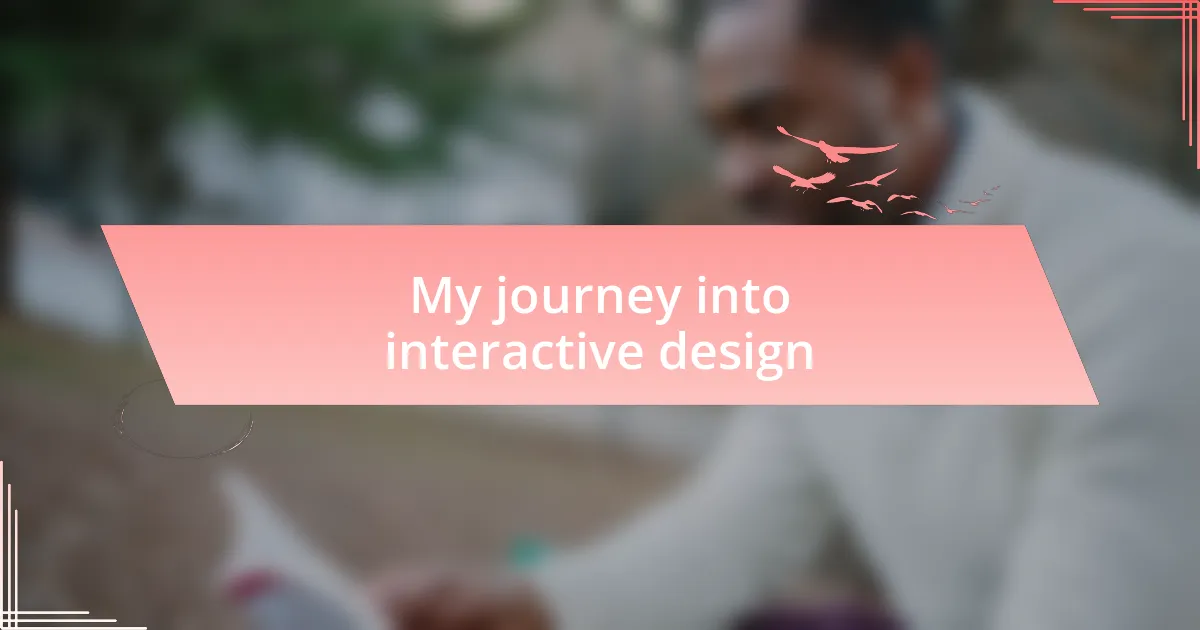Key takeaways:
- Empathy in design enhances user experiences by ensuring intuitive navigation and responsiveness.
- Involving users and seeking feedback is crucial for creating effective interactive designs.
- Simplicity in design improves user engagement by reducing clutter and enhancing focus on content.
- Emotional resonance through storytelling in design can significantly enrich user satisfaction and connection.

Understanding interactive design concepts
Interactive design is all about creating engaging experiences. I remember the first time I interacted with a beautifully designed website; every click felt intuitive, every transition smooth. I couldn’t help but wonder how such designs could grip and guide users so effectively.
At its core, interactive design hinges on understanding user behavior. I’ve noticed that when designers prioritize empathy—putting themselves in the users’ shoes—the designs become more intuitive. Have you ever been frustrated by a confusing layout? That frustration quickly fades when designers integrate feedback loops and responsive elements, ensuring users feel heard and valued throughout their journey.
Consider how the smallest details can make a significant impact. I once worked on a project where simple hover animations made content discovery so much more enjoyable. It was a revelation to me; these elements suddenly brought the static page to life, inviting exploration. It made me realize that interactive design isn’t just about visuals—it’s about dialogue. When elements respond to user actions, it fosters a connection. This kind of responsiveness tells users, “I see you,” making their interactions feel more personal and meaningful.

My journey into interactive design
My journey into interactive design began unexpectedly during a freelance project for a local non-profit. I recall staring at a basic website layout, feeling an urge to make it more engaging. It struck me then: how can I transform this mundane interface into an experience that resonates? That question propelled me into exploring various design principles, each revelation fueling my desire to create something more impactful.
As I dove deeper, I often found myself experimenting with different tools and techniques. One memorable moment was when I implemented a dynamic scrolling feature on a blog. The first time I tested it, I felt an overwhelming sense of satisfaction watching the content unfold seamlessly in front of me. Isn’t it amazing how a simple interaction can evoke that feeling of joy? That’s the magic I’ve discovered in interactive design—a passion to not just inform but to engage and inspire.
Reflecting on my experiences, it became clear that every interaction holds potential. I remember a user telling me that a particular button’s animated response made them feel “invited” to explore more. That kind of feedback is a reminder of why I pursue interactive design. It’s not just about aesthetics; it’s about creating an environment where users feel excited and empowered to interact. How rewarding it is to foster such connections through thoughtful design!

Practical tips for enhancing e-reading
When it comes to enhancing e-reading, I have found that adjusting font size and style can make a world of difference. There was a time when I struggled to enjoy e-books due to eye strain, but switching to a sans-serif font and increasing the size boosted my reading comfort dramatically. Have you ever noticed how a simple tweak can transform an experience from frustrating to enjoyable?
Another effective tip is to utilize customizable background colors. I once experimented with different hues while reading, discovering that a soft sepia tone greatly reduced glare, allowing me to read for hours without discomfort. Isn’t it fascinating how color can affect our mood and focus? Finding the right color palette for e-reading can genuinely enhance engagement, drawing readers into the content.
Lastly, I highly recommend taking breaks to prevent fatigue. I learned this the hard way during a long reading marathon when my focus began to wane. Setting a timer for short breaks not only rejuvenated my mind but also helped me retain more information. Isn’t it interesting how a brief pause can refresh our perspective and renew our interest?

Lessons learned from my experience
One of the most significant lessons I’ve learned is the importance of user feedback in interactive design. Early in my journey, I created a feature without consulting potential users, only to realize it didn’t meet their needs at all. This taught me that involving users not only shapes a better product but also fosters a stronger connection with them. Have you ever felt misunderstood by a product that was supposed to make your life easier?
Another key takeaway from my experience is the power of simplicity. I initially tried incorporating numerous features to enhance the reading experience, thinking more options meant better engagement. However, I soon realized that an uncluttered interface is far more inviting. When I streamlined the navigation, I noticed users spending more time absorbed in their reading instead of getting lost in the maze of options. Isn’t it amazing how less can truly be more?
Lastly, I’ve discovered that emotional resonance plays a vital role in design. I remember the moment I decided to focus on storytelling elements in the interface; it created a warm, inviting atmosphere for readers. Being able to connect content with emotions not only amplified user satisfaction but also enriched their overall experience. Have you ever been captivated by a design that spoke to you on a personal level?